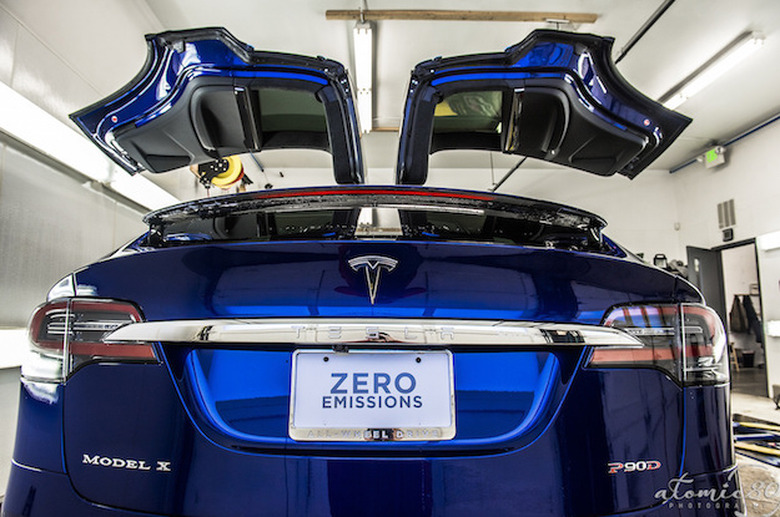Consumer Reports Ranks Tesla As One Of The Least Reliable Car Brands On The Planet
If it wasn't already, I think it's now safe to say that Consumer Reports' on-and-off-again love affair with Tesla is officially over. In a new tally ranking the 10 least reliable cars, the Model X makes an unceremonious appearance, joining the likes of the Ford Fiesta and the Fiat 500L. That Tesla's SUV made the list should hardly come as a surprise for anyone who has been paying close attention to early reviews of the luxury vehicle. From faulty doors and wonky electronics, some of the first impressions of the Tesla Model X were far from positive.
Calling the gargantuan Model X "more showy than practical," Consumer Reports identified the following problem areas with the vehicle: "Falcon-wing doors, locks and latches, power equipment, in-car electronics, climate system." That's quite a laundry list of problem areas, especially for a luxury SUV that starts at $85,000.
DON'T MISS: 'The Walking Dead' season 7 premiere had two awesome moments you probably missed
With the Model X apparently tarnishing the entirety of Elon Musk's beloved brand, Tesla came in 25th on Consumer Reports' list of the 29 most reliable car brands, sandwiched between GMC and Dodge. As a point of interest, the top 5 most reliable car brands were Lexus, Toyota, Buick, Audi and Kia.
While most of Consumer Reports' ire was directed at the Model X, recall that the publication has also had some negative things to say about the Model S. Just last year, for example, the publication pulled its recommendation for the Model S citing reliability issues. "The main problem areas," the report said at the time, "involved the drivetrain, power equipment, charging equipment, giant iPad-like center console, and body and sunroof squeaks, rattles, and leaks." Notably, Elon Musk was quick to respond to said allegations.
Though Consumer Reports can sometimes be a bit hasty its judgements, there's no denying that early production models of the Model X were not quite up to snuff with Tesla's stated standard of excellence. For instance, recall Fortune's review of the Model X from a few months back. While reviewer Sue Callaway found a lot to like with Tesla's crossover SUV, she had a startling observation regarding the seat design.
Tesla promised me that the Model X's second-row seats move in such a way as to allow a baby seat to be in place and yet still move to access the third row. I borrowed a friend's three-month-old baby—yes, really—and her Uppababy Mesa babyseat and discovered very quickly that the system moved the rear-facing seat far enough forward to hit the back of the driver's seat. Worse, it started to tip the second-row seats, squeezing the car seat's frame with the baby in it. Definitely not okay.
In another instance of Tesla quality control gone awry, recall the experience of Tesla enthusiast Byron Deeter who was one of the first owners to get behind the wheel of a Model X. As an early adopter, Deeter was more than happy to live with a few mildly frustrating bugs, but the problems he faced were truly over the top. A few months ago, Deeter explained how the driver's side door on his Model X wouldn't open from the outside, forcing him to enter in from the passenger side and stretch out across the seats to open it up from the inside. And as if that weren't enough, the door wouldn't fully close once he managed to open it.
"I could manually close it, but the car couldn't sense that the door was shut, so the electric control wouldn't latch," Deeter said a few months ago. "Yesterday, I literally drove to a meeting holding the door closed."
"It's definitely a reminder that quality control with human mobility and safety is critical," Deeter said in an interview with TechCrunch at the time. "In this case, Tesla did push out some software and maybe some hardware that wasn't quite ready for prime time."
Addressing many of the initial complaints that surfaced with early Model X owners, Tesla back in April issued the following statement.
"We are committed to making the world's most reliable cars," Tesla said. "While we have seen some issues with early Model X builds, the issues are not widespread, and we are working closely with each owner to respond quickly and proactively to address any problems. We will continue to do so until each customer is fully satisfied. This commitment is one of the reasons why 98% of our customers say they will buy another Tesla as their next car."
Indeed, Tesla Model X owners do seem to be overwhelmingly satisfied, but that data point apparently doesn't factor into Consumer Reports' reliability calculus.
